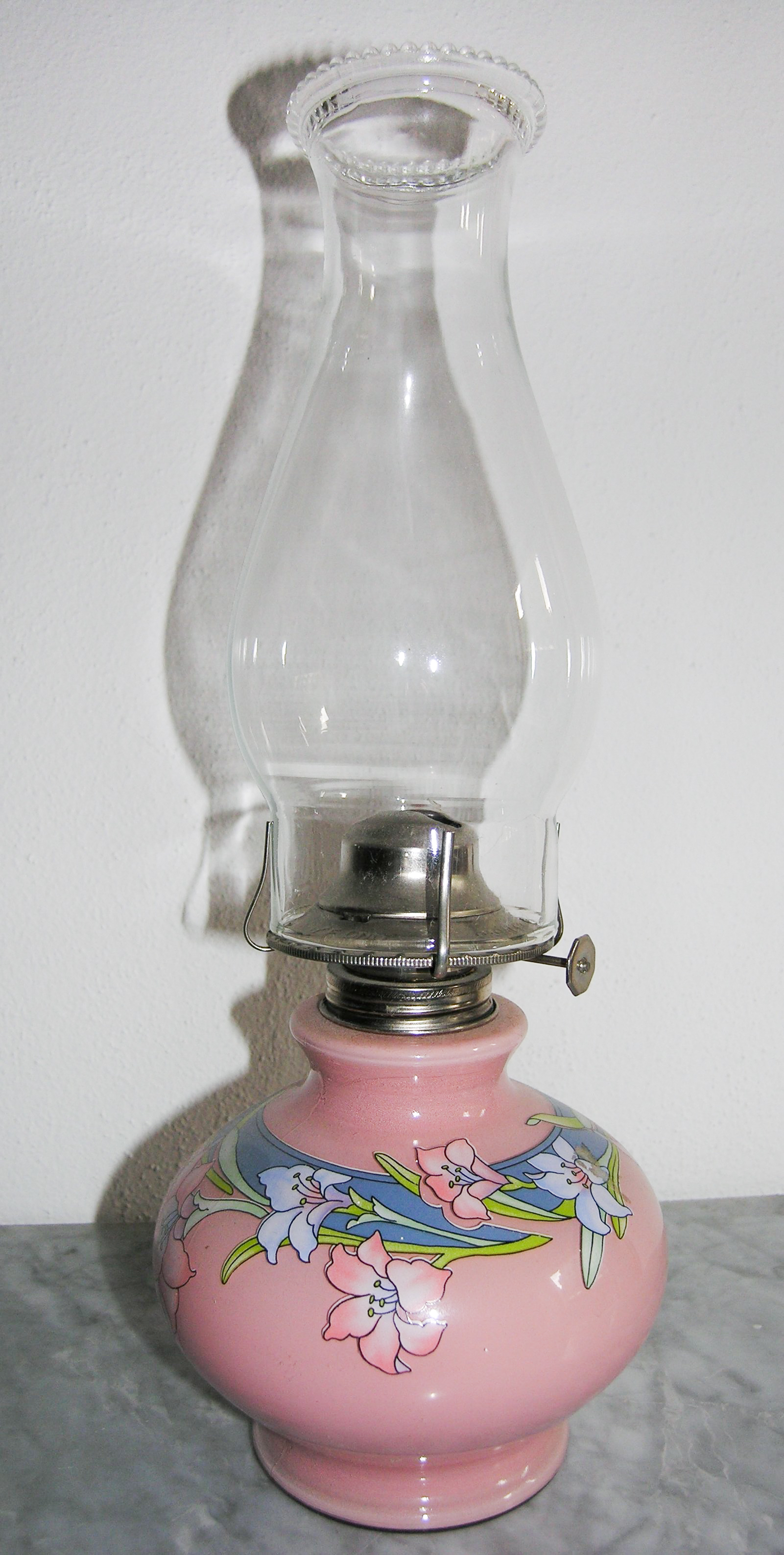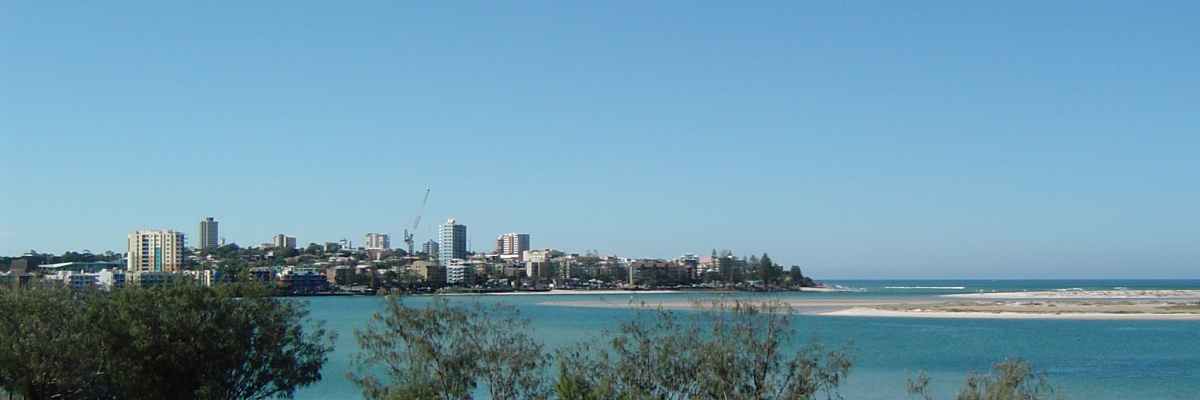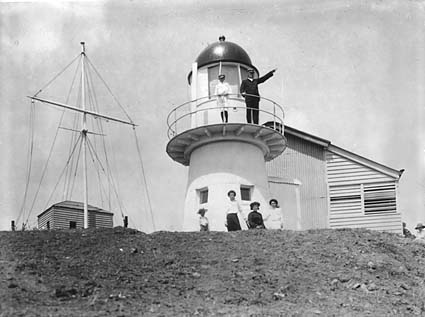|
Old Caloundra Light
Old Caloundra Light, also known as Old Caloundra Head Light or Cape Caloundra Light, is an inactive lighthouse located in Caloundra on the Sunshine Coast in South East Queensland, Australia. It is the oldest surviving building in Caloundra. The lighthouse was active between 1896 and 1968. The tower was relocated twice. In 1970 it was relocated from its original location to Woorim Park in Caloundra, and in 1999 it was returned to its original site on Canberra Terrace near downtown Caloundra, where it stands today. History Operation The need for a lighthouse at Caloundra Head arose in 1879 with the sounding of the North West Channel, a deep water channel into Moreton Bay and the Port of Brisbane, the principal port of Queensland. The channel went from Caloundra Head along the eastern shore of Bribie Island. Although the channel became the most used entry channel into the port, it was only lit in 1896, when a pair of mobile leading lights were established on Bribie Island, the Cal ... [...More Info...] [...Related Items...] OR: [Wikipedia] [Google] [Baidu] |
New Caloundra Light
New Caloundra Light, also known as New Caloundra Head Light, is an inactive lighthouse located in Caloundra on the Sunshine Coast in South East Queensland, Australia. It stands on Canberra Terrace near downtown Caloundra. The lighthouse was active from 1968 to 1992. It has a unique design resembling an airport control tower, the only surviving example of a lighthouse of this design in Australia. History Old Caloundra Light had stood on Canberra Terrace since its construction in 1896, marking the entrance to the North West Channel, a deep water channel into Moreton Bay and the Port of Brisbane. Changes in the shipping industry in the 1960s caused an increase in large container ships, which made the channel even more important. In May 1966 permission was granted for the construction of a modern structure comprising a combined lighthouse, signal station and radar station. The New Caloundra Light was erected in 1967, and was the second of a group of seven concrete towers erected b ... [...More Info...] [...Related Items...] OR: [Wikipedia] [Google] [Baidu] |
Hardwood
Hardwood is wood from dicot trees. These are usually found in broad-leaved temperate and tropical forests. In temperate and boreal latitudes they are mostly deciduous, but in tropics and subtropics mostly evergreen. Hardwood (which comes from angiosperm trees) contrasts with softwood (which is from gymnosperm trees). Characteristics Hardwoods are produced by angiosperm trees that reproduce by flowers, and have broad leaves. Many species are deciduous. Those of temperate regions lose their leaves every autumn as temperatures fall and are dormant in the winter, but those of tropical regions may shed their leaves in response to seasonal or sporadic periods of drought. Hardwood from deciduous species, such as oak, normally shows annual growth rings, but these may be absent in some tropical hardwoods. Hardwoods have a more complex structure than softwoods and are often much slower growing as a result. The dominant feature separating "hardwoods" from softwoods is the presence o ... [...More Info...] [...Related Items...] OR: [Wikipedia] [Google] [Baidu] |
Candela
The candela ( or ; symbol: cd) is the unit of luminous intensity in the International System of Units (SI). It measures luminous power per unit solid angle emitted by a light source in a particular direction. Luminous intensity is analogous to radiant intensity, but instead of simply adding up the contributions of every wavelength of light in the source's spectrum, the contribution of each wavelength is weighted by the standard luminosity function (a model of the sensitivity of the human eye to different wavelengths). A common wax candle emits light with a luminous intensity of roughly one candela. If emission in some directions is blocked by an opaque barrier, the emission would still be approximately one candela in the directions that are not obscured. The word ''candela'' is Latin for ''candle''. The old name "candle" is still sometimes used, as in ''foot-candle'' and the modern definition of ''candlepower''. Definition The 26th General Conference on Weights and Measures (C ... [...More Info...] [...Related Items...] OR: [Wikipedia] [Google] [Baidu] |
Gas Mantle
A Coleman white gas lantern mantle glowing at full brightness An incandescent gas mantle, gas mantle or Welsbach mantle is a device for generating incandescent bright white light when heated by a flame. The name refers to its original heat source in gas lights which illuminated the streets of Europe and North America in the late 19th century. ''Mantle'' refers to the way it hangs like a cloak above the flame. Gas mantles were also used in portable camping lanterns, pressure lanterns and some oil lamps. Gas mantles are usually sold as fabric items, which, because of impregnation with metal nitrates, burns away to leave a rigid but fragile mesh of metal oxides when heated during initial use; these metal oxides produce light from the heat of the flame whenever used. Thorium dioxide was commonly a major component; being radioactive, it has led to concerns about the safety of those involved in manufacturing mantles. Normal use, however, poses minimal health risk. Mechanism l ... [...More Info...] [...Related Items...] OR: [Wikipedia] [Google] [Baidu] |
Lighthouse Keeper
A lighthouse keeper or lightkeeper is a person responsible for tending and caring for a lighthouse, particularly the light and lens in the days when oil lamps and clockwork mechanisms were used. Lighthouse keepers were sometimes referred to as "wickies" because of their job trimming the wicks. Duties and functions Historically, lighthouse keepers were needed to trim the wicks, replenish fuel, wind clockworks and perform maintenance tasks such as cleaning lenses and windows. They were also responsible for the fog signal and the weather station, and played a major role in search and rescue at sea. Because most lighthouses are located in remote, isolated or inaccessible areas on islands and coastlines, it was typical for the work of lighthouse keeper to remain within a family, passing from parents to child, all of whom lived in or near the lighthouse itself. "Stag light" was an unofficial term given to some isolated lighthouses in the United States Lighthouse Service. It meant sta ... [...More Info...] [...Related Items...] OR: [Wikipedia] [Google] [Baidu] |
Kerosene Lamp
A kerosene lamp (also known as a paraffin lamp in some countries) is a type of lighting device that uses kerosene as a fuel. Kerosene lamps have a wick or mantle as light source, protected by a glass chimney or globe; lamps may be used on a table, or hand-held lanterns may be used for portable lighting. Like oil lamps, they are useful for lighting without electricity, such as in regions without rural electrification, in electrified areas during power outages, at campsites, and on boats. There are three types of kerosene lamp: flat-wick, central-draught (tubular round wick), and mantle lamp. Kerosene lanterns meant for portable use have a flat wick and are made in dead-flame, hot-blast, and cold-blast variants. Pressurized kerosene lamps use a gas mantle; these are known as Petromax, Tilley lamps, or Coleman lamps, among other manufacturers. They produce more light per unit of fuel than wick-type lamps, but are more complex and expensive in construction and more complex to o ... [...More Info...] [...Related Items...] OR: [Wikipedia] [Google] [Baidu] |
Caloundra Lighthouse And Keeper's Residence, Ca 1920
Caloundra ( ) is a coastal town and the southernmost town in the Sunshine Coast Region in South East Queensland, Australia. Geography Caloundra is north of the Brisbane central business district. Caloundra is accessible from Landsborough railway station, 21 km away, and the Caloundra bus station. Bribie Island North is located across the Pumicestone Passage. Caloundra marks the coastal, northern extent of the Moreton Bay Marine Park. History Caloundra lies within the Aboriginal Gubbi Gubbi (Kabi Kabi, Cabbee, Carbi, Gabi Gabi) language region. The name ''Caloundra'' is from the Gubbi Gubbi language ''Cullowundoor'' with ''Kal Owen'' meaning 'beech tree' (''Gmelina leichhardtii'') and ''Dha'' meaning 'place'. Caloundra Head was previously known as Petrie Point and Point Wickham (or Wickham Point). Point Wickham takes its name from John Clements Wickham, who did a hydrographic survey of the northern section of Moreton Bay in 1846 and was later the Government Resident o ... [...More Info...] [...Related Items...] OR: [Wikipedia] [Google] [Baidu] |
Bulwer Island Light
Bulwer Island Light, also known as Bulwer Island Range Rear Light, is an inactive lighthouse that was on Bulwer Island, in the suburb of Pinkenba, City of Brisbane, Queensland, Australia. In 1983, it was moved to the Queensland Maritime Museum in South Brisbane. History The station was established in 1909. The current light was lit in 1912, as the rear light of a pair of leading lights at the mouth of Brisbane River. It was at the northern end of Bulwer Island on the eastern side directly adjacent to the river (). Made of hardwood frame clad with corrugated iron, it was the eight and last of its kind to be constructed, the first seven being Little Sea Hill Light, Grassy Hill Light, Goods Island Light, Bay Rock Light, Old Caloundra Head Light, North Point Hummock Light (demolished) and Gatcombe Head Light (demolished). In 1983 the lighthouse was replaced by a skeletal tower, and relocated to the Queensland Maritime Museum. The original location was adjacent to the Bulwer Isla ... [...More Info...] [...Related Items...] OR: [Wikipedia] [Google] [Baidu] |
North Point Hummock Light
North Point Light, also known as North Point Hummock Light, was located on North Point, the most northern point on Moreton Island. North Point Light was constructed in the early 1860s, carrying a large kerosene burner with a reflector. In 1899, the lighthouse was replaced with a hardwood framed structure, clad with corrugated iron. It was the sixth of a group of eight lighthouses in Queensland constructed this way, including, by order of establishment, Little Sea Hill Light, Grassy Hill Light, Goods Island Light, Bay Rock Light, Old Caloundra Light, itself, Gatcombe Head Light and Bulwer Island Light. Oddly, a 1909 listing still describes the light as a square wooden lightroom, carrying a fixed sixth order dioptric Dioptrics is the branch of optics dealing with refraction, similarly the branch dealing with mirror A mirror or looking glass is an object that Reflection (physics), reflects an image. Light that bounces off a mirror will show an image of ... apparatus. ... [...More Info...] [...Related Items...] OR: [Wikipedia] [Google] [Baidu] |
Bay Rock Light
Bay Rock Light is an inactive lighthouse which used to be located on Bay Rock, a rocky islet northwest of Magnetic Island, about north of Townsville, Queensland, Australia. First lit in 1886, it was automated in 1920 and deactivated in the 1980s. It was relocated in 1992 to the Townsville Maritime Museum, where it is now displayed. History Bay Rock Light was first lit in 1886. It was originally located on Bay Rock, at location , its main use being assisting vessels into a quarantine station on West Point, Magnetic Island. It also assisted passage into Cleveland Bay or to a main shipping anchorage off Bay Rock. The lighthouse was high, made of a timber frame clad with zinc- annealed galvanized corrugated iron sheets. It was the fourth in a group of eight lighthouses made of hardwood frame clad with corrugated iron, which included, by order of establishment Little Sea Hill Light, Grassy Hill Light, Goods Island Light, itself, Old Caloundra Light, North Point Hummock Light ... [...More Info...] [...Related Items...] OR: [Wikipedia] [Google] [Baidu] |
Goods Island Light
Goods Island Light is an active lighthouse located on the highest point of Goods Island (Palilag), an island in the Torres Strait, belonging to Queensland, Australia. It serves as the rear light of the Goods Island Range, pointing out the entrance to Normanby Sound. History The first navigation aid on Goods Island was a signalling station, established in 1877. In 1882, pearl fishers operating in Torres Strait requested that a light be established at the western entrance to the straight. Their request was accepted by George Heath, chairman of the Queensland Marine Board, who dictated the location of Goods Island. A temporary light installed on the signalman's quarters was finally replaced by the lighthouse, constructed in 1886. It was the third in a group of eight lighthouses in Queensland made of hardwood frame clad with corrugated iron, which includes, in order of establishment Little Sea Hill Light, Grassy Hill Light, itself, Bay Rock Light, Old Caloundra Light, North Point ... [...More Info...] [...Related Items...] OR: [Wikipedia] [Google] [Baidu] |
Grassy Hill Light
Grassy Hill Light, also known as Cooktown Light, is an active lighthouse located on Grassy Hill above Cooktown, Queensland, Australia, on the south side of the entrance to Endeavour River. History Grassy Hill was the site of Lieutenant James Cook landing in 1770. Cooktown was established in October 1873 to accommodate for the Palmer River Gold Rush, and became a thriving port in the 1880s. The first lights in and out of the port were leading lights set on sheds on the wharves. A signal staff was erected on Grassy Hill in 1874 to announce incoming ships, and a cottage was constructed for the signal staff operator in 1878–79. By 1882 a temporary light was set on the hill. In 1883 and 1884, George Poynter Heath, Portmaster of Queensland and Chairman of the Queensland Marine Board at that time, made two reports to the parliament, recommending that the temporary light be replaced with a permanent building and a proper apparatus. Grassy Hill Light was finally constructed in 1886. It ... [...More Info...] [...Related Items...] OR: [Wikipedia] [Google] [Baidu] |



